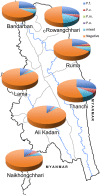High prevalence of asymptomatic malaria in south-eastern Bangladesh
- PMID: 24406220
- PMCID: PMC3896725
- DOI: 10.1186/1475-2875-13-16
High prevalence of asymptomatic malaria in south-eastern Bangladesh
Abstract
Background: The WHO has reported that RDT and microscopy-confirmed malaria cases have declined in recent years. However, it is still unclear if this reflects a real decrease in incidence in Bangladesh, as particularly the hilly and forested areas of the Chittagong Hill Tract (CHT) Districts report more than 80% of all cases and deaths. surveillance and epidemiological data on malaria from the CHT are limited; existing data report Plasmodium falciparum and Plasmodium vivax as the dominant species.
Methods: A cross-sectional survey was conducted in the District of Bandarban, the southernmost of the three Hill Tracts Districts, to collect district-wide malaria prevalence data from one of the regions with the highest malaria endemicity in Bangladesh. A multistage cluster sampling technique was used to collect blood samples from febrile and afebrile participants and malaria microscopy and standardized nested PCR for diagnosis were performed. Demographic data, vital signs and splenomegaly were recorded.
Results: Malaria prevalence across all subdistricts in the monsoon season was 30.7% (95% CI: 28.3-33.2) and 14.2% (95% CI: 12.5-16.2) by PCR and microscopy, respectively. Plasmodium falciparum mono-infections accounted for 58.9%, P. vivax mono-infections for 13.6%, Plasmodium malariae for 1.8%, and Plasmodium ovale for 1.4% of all positive cases. In 24.4% of all cases mixed infections were identified by PCR. The proportion of asymptomatic infections among PCR-confirmed cases was 77.0%, oligosymptomatic and symptomatic cases accounted for only 19.8 and 3.2%, respectively. Significantly (p < 0.01) more asymptomatic cases were recorded among participants older than 15 years as compared to younger participants, whereas prevalence and parasite density were significantly (p < 0.01) higher in patients younger than 15 years. Spleen rate and malaria prevalence in two to nine year olds were 18.6 and 34.6%, respectively. No significant difference in malaria prevalence and parasite density was observed between dry and rainy season.
Conclusions: A large proportion of asymptomatic plasmodial infections was found which likely act as a reservoir of transmission. This has major implications for ongoing malaria control programmes that are based on the treatment of symptomatic patients. These findings highlight the need for new intervention strategies targeting asymptomatic carriers.
Figures



References
-
- World Health Organization. World Malaria Report 2012. http://www.who.int/malaria/publications/world_malaria_report_2012/wmr201....
-
- Cui L, Yan G, Sattabongkot J, Cao Y, Chen B, Chen X, Fan Q, Fang Q, Jongwutiwes S, Parker D, Sirichaisinthop J, Kyaw MP, Su XZ, Yang H, Yang Z, Wang B, Xu J, Zheng B, Zhong D, Zhou G. Malaria in the greater Mekong subregion: heterogeneity and complexity. Acta Trop. 2012;121:227–239. doi: 10.1016/j.actatropica.2011.02.016. - DOI - PMC - PubMed
-
- Noedl H, Se Y, Sriwichai S, Schaecher K, Teja-Isavadharm P, Smith B, Rutvisuttinunt W, Bethell D, Surasri S, Fukuda MM, Socheat D, Chan Thap L. Artemisinin resistance in Cambodia: a clinical trial designed to address an emerging problem in Southeast Asia. Clin Infect Dis. 2010;51:e82–e89. doi: 10.1086/657120. - DOI - PubMed
MeSH terms
LinkOut - more resources
Full Text Sources
Other Literature Sources
Medical

